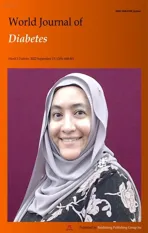Relationship between age of pregnant women with gestational diabetes mellitus and mode of delivery and neonatal Apgar score
2022-09-16LanGaoCunRenChenFeiWangQunJiKaiNingChenYangYangHaiWeiLiu
INTRODUCTION
Gestational diabetes mellitus (GDM) is one of the specific diseases of pregnant women. It refers to abnormal glucose tolerance in different degrees during pregnancy, often accompanied by obvious changes in glucose and lipid metabolism, and is closely related to adverse pregnancy outcomes. The incidence rate of GDM is increasing annually in China. GDM results in a high-risk pregnancy, which can induce complications, such as abortion, premature delivery, amniotic fluid and infection[1,2]. The incidence of fetal distress, polyhydramnios, puerperal infection, premature delivery, and macrosomia in pregnant women with GDM are higher than in those without GDM[3,4]. Pregnancy at the right age is the key to reduce the risk of adverse outcomes. With the implementation of China’s three-child policy,the number of pregnant women with advanced maternal age is gradually increasing, and the incidence of pregnancy complications is significantly higher than that in right-age pregnant women. In recent years, with the rapid development of medical technology, significant progress has been made in the treatment of birth defects and premature infants. However, there are no effective measures to avoid the adverse outcomes of older-age pregnancies, especially those with GDM. Previous studies have shown that body mass index (BMI) may have an impact on maternal and neonatal outcomes in pregnant women with GDM[5,6]. However, pregnancy is still a risk factor for adverse maternal and neonatal outcomes and is affected by many factors. The clinical data of 583 pregnant women with GDM who delivered in the Department of Obstetrics at our hospital between March 2019 and March 2022 were retrospectively analyzed. The delivery mode and neonatal Apgar score of pregnant women with GDM at different ages were compared, to improve the pregnancy outcome of the older pregnant women, and provide a reference for ensuring the effect of eugenics and prenatal care.
MATERIALS AND METHODS
General data
The clinical data of 583 pregnant women with GDM who delivered in the Department of Obstetrics at our hospital between March 2019 and March 2022 were retrospectively analyzed. This study was approved by the Ethics Committee of our hospital. Inclusion criteria were: (1) All women conformed to the clinical diagnostic criteria for GDM[7]; (2) regular pregnancy examination; (3) successful delivery; (4)no hereditary diseases of coagulation system; (5) complete clinical medical records; and (6) pregnant women and family members gave informed consent to participate in this study.
The number of women with assisted pregnancy, ≤ 37 wk gestation, ≥ 2 pregnancies, one or more deliveries, and no pre-pregnancy blood glucose screening in the older group were all higher than those in the right age group (
0.05) (Table 1).
Exclusion criteria were: (1) Women were diagnosed with diabetes mellitus or impaired glucose regulation before pregnancy; (2) women with other pregnancy-related diseases; (3) heart, liver or kidney dysfunction; (4) hematological diseases; (5) other diseases that may affect blood glucose; and (6) mental illness or retardation. Among the selected pregnant woman, 377 aged < 35 years were selected as the right age group and 206 aged > 35 years were selected as the older group. The data flow chart is shown in Figure 1.
The older group had a higher cesarean section rate, higher incidence of polyhydramnios and postpartum hemorrhage, and lower incidence of fetal distress than the right age group. The right age group had higher Apgar scores at 1 and 5 min after birth than the older group. Moreover, age,education level and premature rupture of membranes were risk factors for adverse pregnant outcomes in older GDM women. Our results showed that gestational age greater than 35 years old will increase the incidence of gestational diabetes and adverse pregnancy outcomes, but it needs to be confirmed by large samples and studies involving patients in multiple research centers.
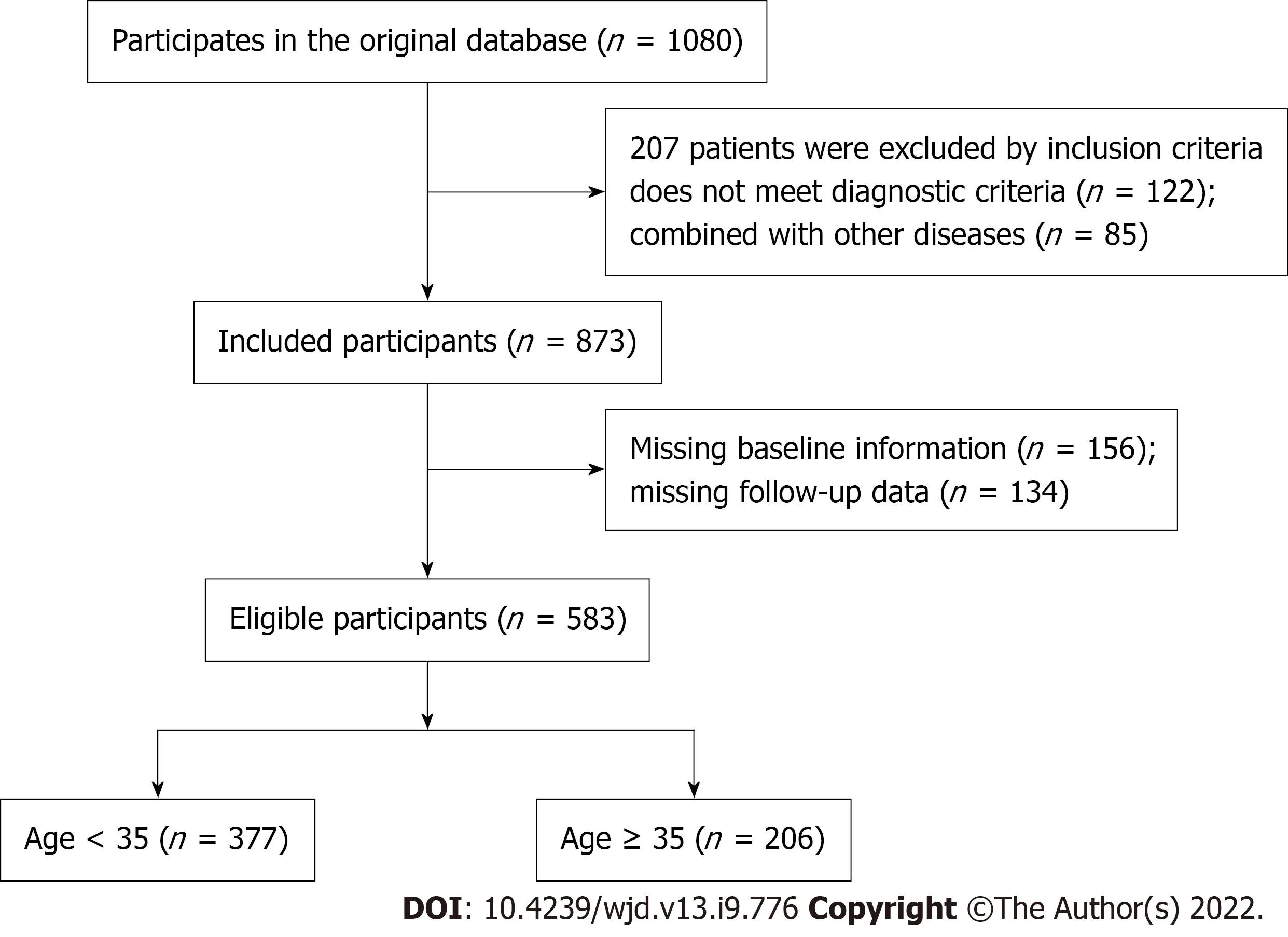
Clinical data selection
The clinical data of the two groups were collected, including: age; pregnancy mode; educational level;BMI; fasting blood glucose; gestational weeks of delivery; number of pregnancies; number of deliveries;pre-pregnancy blood glucose screening; maternal and infant outcomes (preterm birth, polyhydramnios,oligohydramnios, fetal distress, macrosomia, umbilical cord around the neck, neonatal death events,neonatal hospitalization, neonatal aspiration pneumonia, neonatal hypoglycemia, neonatal jaundice,and postpartum hemorrhage); and Apgar scores at 1 and 5 min after birth. The clinical data of pregnant women in the two groups were retrospectively analyzed. In the older group, 159 women were classed as the adverse outcome group and 47 as the good outcome group according to whether they had adverse maternal and infant outcomes.
I should like to see Rome, she said; it must be a lovelycity, or so many foreigners would not be constantly arriving there.Now, do give me a description of Rome. How does the city look when you enter in at the gate?
Diagnostic criteria
GDM was diagnosed by the International Association of Diabetes and Pregnancy Study Group(IADPSG) criteria. The IADPSG recommends testing to be routinely carried out between 24 and 28 wk of gestation or at the first prenatal visit in high-risk women. Based on the results of a 75-g, 2-h oral glucose tolerance test, a woman was diagnosed with GDM when one or more of her plasma glucose concentrations were equivalent to or exceeded the following levels: fasting, 92 mg/dL; 1 h, 180 mg/dL;or 2 h, 153 mg/dL.
Statistical analysis
The right age pregnant women had a higher natural delivery rate of 40.85% compared with 22.5% in the older group (
< 0.05). The older group had a higher cesarean section rate of 77.67% compared with 59.15% in the right age group (
0.05) (Table 2).
RESULTS
Comparison of general data of pregnant women with GDM in two groups
A hind is another word for a doe and stands in many myths for the female animal in general, which can have a demonic character (Biedermann 96).Return to place in story.
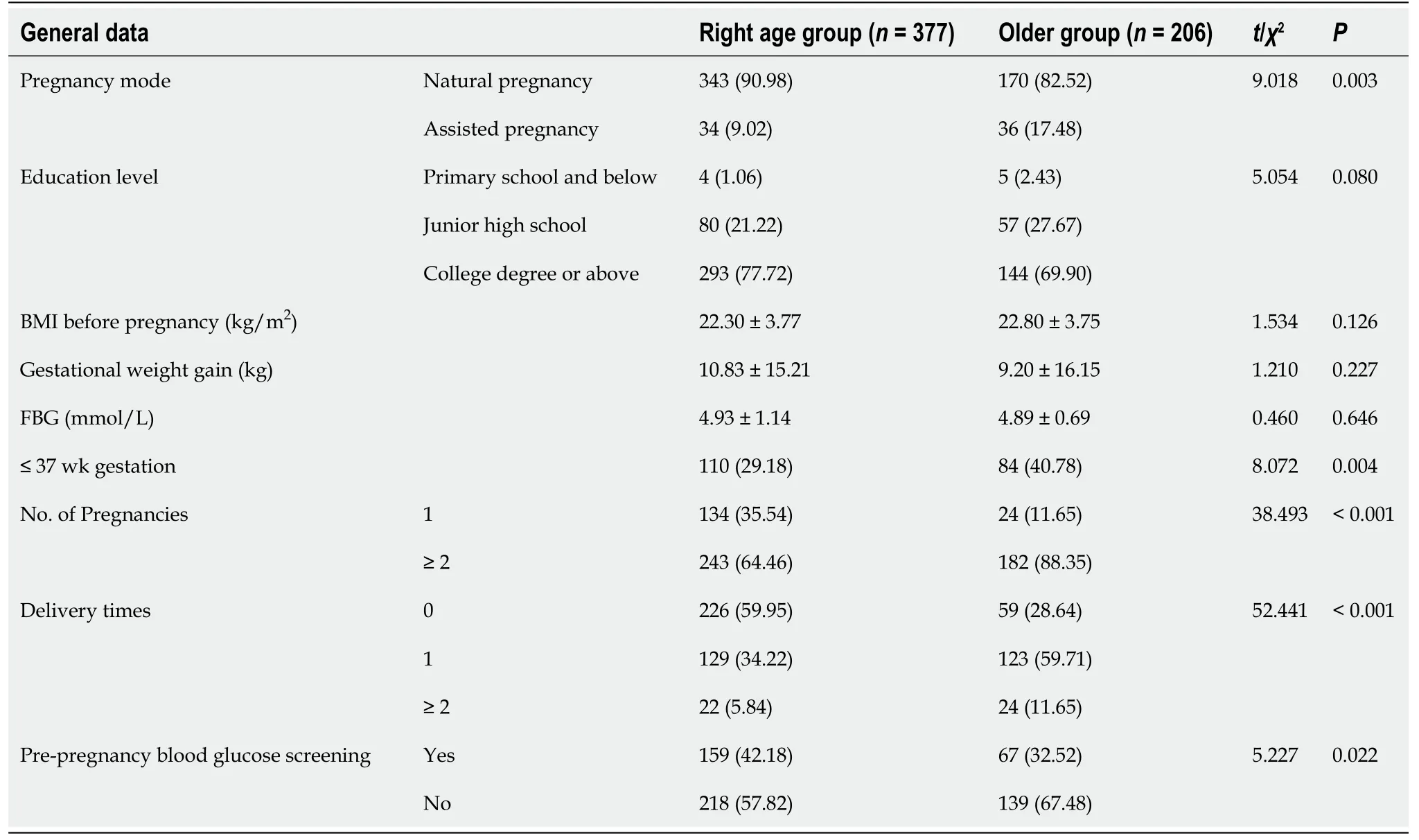
Comparison of delivery modes between the two groups
The data in this study were analyzed using SPSS 21.0. The measurement data were expressed as mean ±SD, and were compared using the independent sample
test between two groups. The enumeration data were expressed as
(%), and were compared using the
test between two groups. Factors related to adverse maternal and infant outcomes in older pregnant women were analyzed using logistic regression analysis.
< 0.05 was regarded as statistically significant.
GDM is a special type of diabetes with a morbidity of 17.5%-18.9%, and the morbidity increases withage[8]. GDM increases the morbidity of pregnancy-related complications, which could lead to adverse pregnancy outcomes such as premature delivery, cesarean section, macrosomia and premature rupture of membranes, thus attracting the attention of the majority of medical staff and pregnant women[9,10].Some scholars have found that gestational age > 35 years, pre-pregnancy BMI, and family history of diabetes are all risk factors for GDM, which increasing the incidence of adverse pregnancy outcomes such as premature delivery, macrosomia and fetal distress[11,12]. Previous studies have mainly focused on the high-risk factors of GDM[13-15], and have confirmed that advanced age is a risk factor for GDM.However, there has been less research on older women with GDM. In this study, we retrospectively analyzed the clinical data of older and right-age pregnant women with GDM. The general situation,delivery mode, and maternal and neonatal outcomes were compared, and the delivery characteristics of women with GDM at different ages were discussed, aiming to improve pregnancy outcome in the older age group and providing a reference for ensuring the effect of eugenics in China.

Comparison of adverse outcomes between two groups
Hainan Province Clinical medical center and The High-level Talent Project of Hainan Provincial Natural Science Foundation, No.821RC685.
Comparison of Apgar score between two groups
No significant difference existed in neonatal weight between the two groups (
> 0.05). The right age group had higher Apgar scores at 1 and 5 min after birth than the older group had (
< 0.05) (Table 4).
Analysis of related factors of adverse maternal and infant outcomes in older pregnant women
Significant differences existed between the poor (
159) and good (
= 47) outcome groups for age,education level, pregnancy mode, ≤ 37 wk gestation weeks, number of pregnancies, and premature rupture of membranes (
< 0.05) (Table 5).
Logistic regression analysis of risk factors for maternal and infant adverse outcomes in older pregnant women with GDM
The interference between the various indicators was controlled and the correlation between these indicators and maternal and infant adverse outcomes in older women with GDM was analyzed by logistic regression analysis. The analysis was conducted using significant factors in Table 5 as independent variables and adverse maternal and infant outcomes as the dependent variable. The regression model was established by selecting the indexes such as age, education level, pregnancy mode, ≤ 37 wk gestation, number of pregnancies, and premature rupture of membranes. Logistic regression showed that age, education level and premature rupture of membranes were risk factors for maternal and infant adverse outcomes in older women with GDM (
< 0.05) (Table 6 and nomogram analysis in Figure 2).
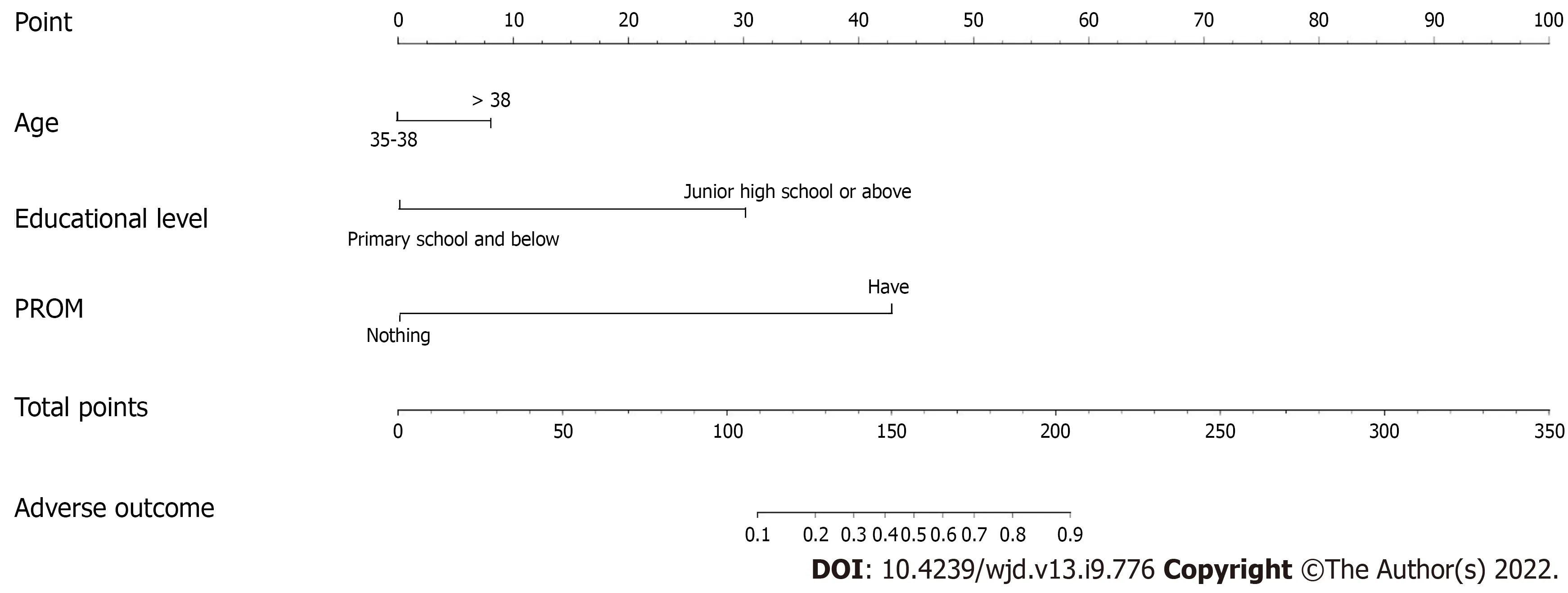
DISCUSSION
By now I had forgotten about the pie and listened to grandma, mesmerized11. What happened then? I hurried her when she took her time eating some pie.
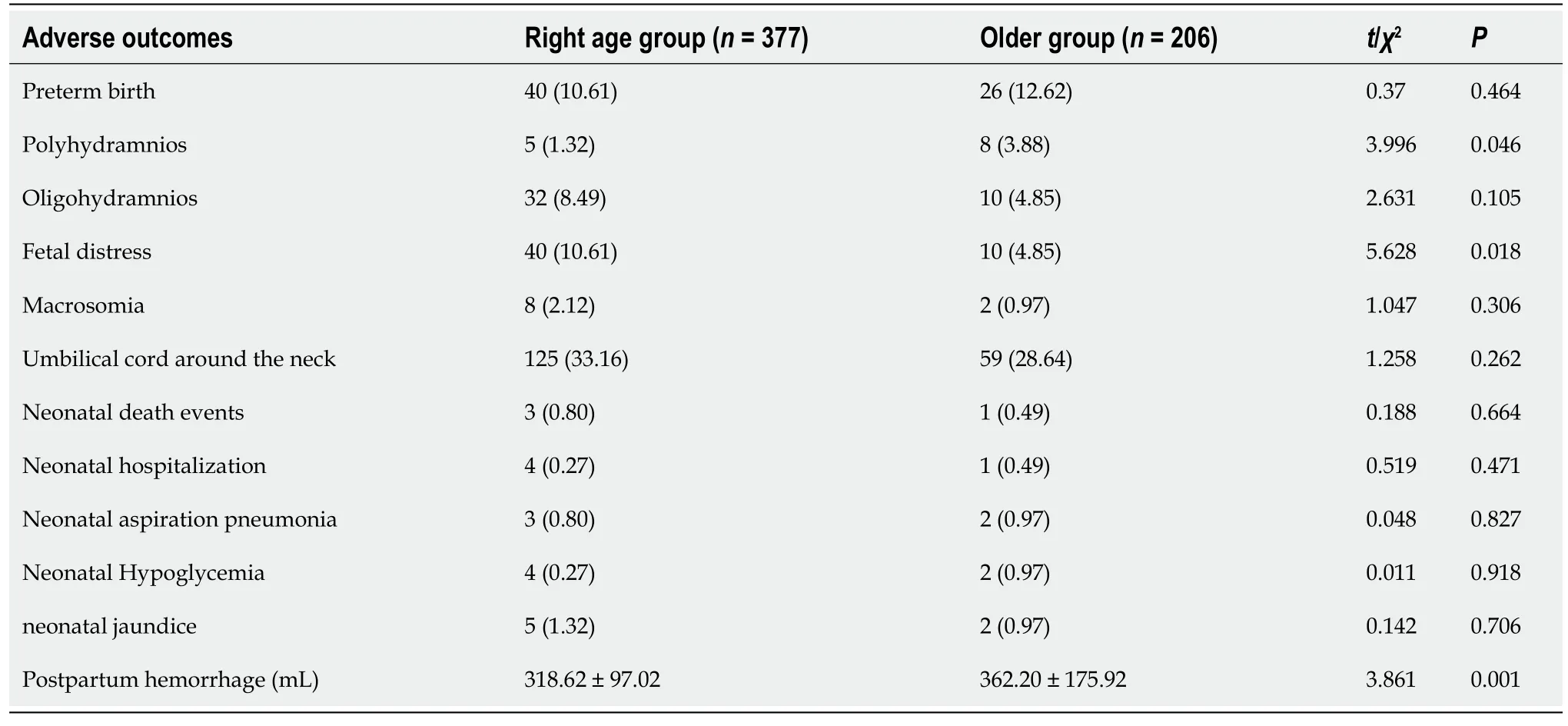

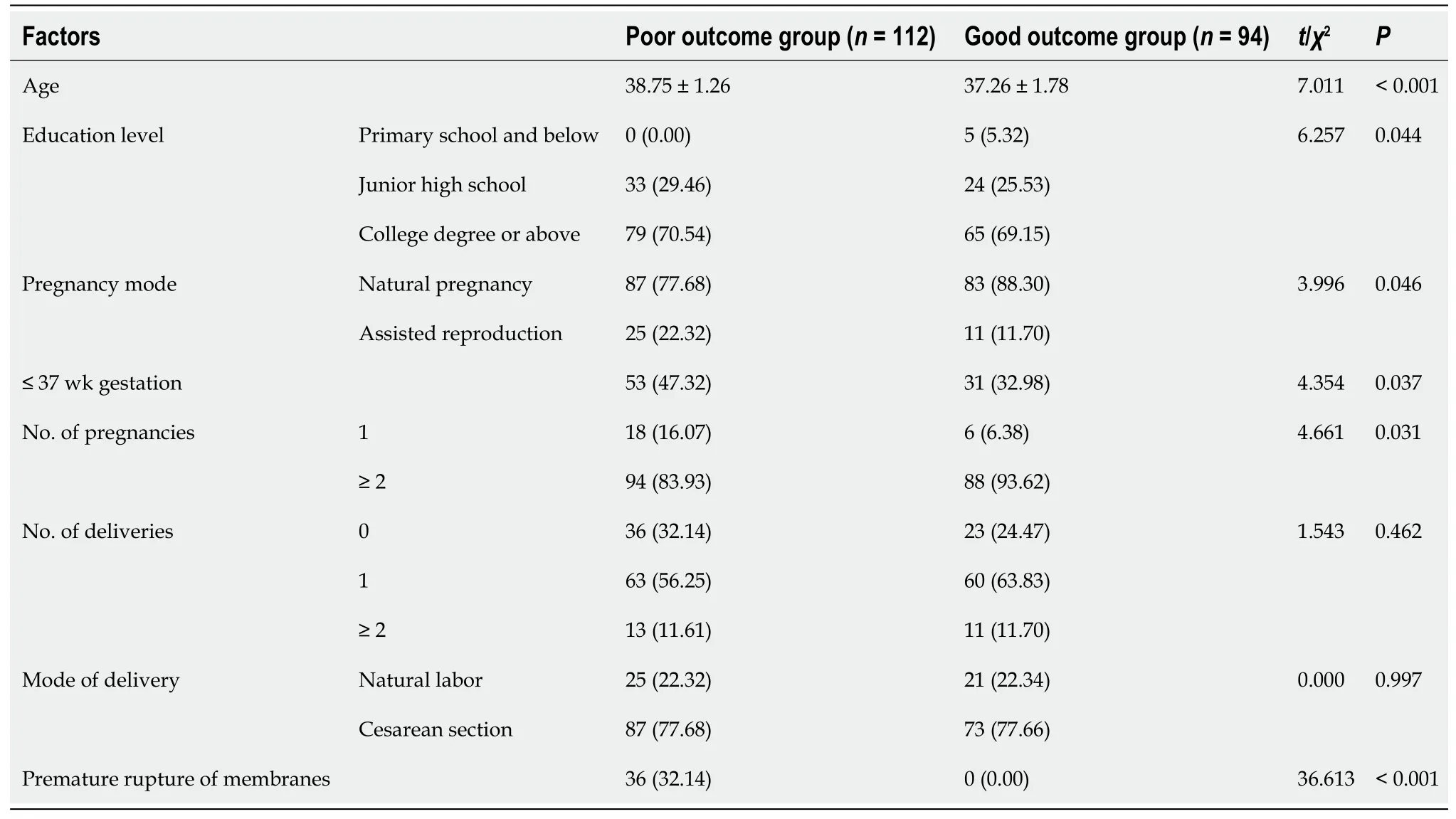

The number of women with assisted pregnancy, ≤ 37 wk gestation, ≥ 2 pregnancies, one or more deliveries, and no pre-pregnancy blood glucose screening in the older group were all higher than those in the right-age group. The ovarian function of older women decreased significantly, and the ovarian reserve and egg quality decreased gradually, resulting in a decline in successful pregnancy rate.Assisted reproductive technology helps a large number of infertile older women conceive successfully,but the complications during pregnancy are higher than those of pregnant women who conceive naturally. With the implementation of the three-child policy in China, the number of older pregnant women is increasing gradually. Older women have a higher incidence of pregnancy complications, such as GDM, and higher risk of maternal and infant deaths than pregnant women at the right age have.Therefore, we should attach importance to the healthcare of older women during pregnancy and in the perinatal period. The results of the present study showed that the older group had a higher cesarean section rate of 77.67%, compared with 59.15% in the right-age group. The right age group had higher Apgar scores at 1 and 5 min after birth compared with the older group. In recent years, the rate of cesarean section has increased due to incorrect fetal position or prevention of fetal distress. There are many pregnancy complications in older women, uterine contraction is weaker, and the total labor process is prolonged. Therefore, natural delivery can increase maternal and neonatal risks. This is one of the reasons why older women choose cesarean section, but this increases the risk of maternal and neonatal infection and thromboembolism[8,16-18]. With increasing age, pregnant women are prone to obesity, and various bodily functions gradually decrease. In older pregnant women with GDM, the incidence of fetal macrosomia is high. We showed that older women had a higher incidence of polyhydramnios and postpartum hemorrhage than the right-age women had, which confirms that GDM is closely related to maternal and infant adverse outcomes. According to previous studies, older age pregnancy has a higher risk of GDM[19-21]. Older age can also increase the probability of gestational hypertension, perinatal complications and other diseases. The present study found that the older group had a lower incidence of fetal distress than the right-age group had, which may be related to the high rate of cesarean section in the older group. The incidence of fetal distress was reduced due to the high proportion of women with ≤ 37 wk gestation in the older group.
To control the interference between the various indicators and analyze the correlation between related indicators and maternal and infant adverse outcomes in older women with GDM, logistic regression analysis was conducted. Logistic regression showed that age, education level and premature rupture of membranes were risk factors for maternal and infant adverse outcomes in older women with GDM. Pregnant women aged > 35 years old are more likely to have pregnancy complications during pregnancy or delivery. Laura estimated the risk of adverse outcome over a pregnancy cycle of 3-24 mo based on the maternal age at the initial birth (20-34 years and ≥ 35 years)[20]. The risk of maternal mortality or serious morbidity at 6 mo of pregnancy was increased compared to the 18-mo pregnancy cycle of women aged ≥ 35 years. Women aged 20-34 years had an increased risk of spontaneous preterm birth within 6 mo of pregnancy. In the present study, with the increase in academic qualifications, the proportion of maternal and infant adverse outcomes in older pregnant women with GDM increased,and there was a significant difference compared with the good outcome group. Education level is a risk factor for maternal and infant adverse outcomes in older women with GDM. The reason may be that the higher the educational background is, the later the childbearing age is, which affects fertility and reproductive quality. Premature rupture of membranes induces serious adverse effects in both the mother and fetus. In premature rupture of membranes, the reproductive tract loses its protective barrier,and the amniotic fluid gradually decreases, which affects the blood circulation of the placenta and increases proneness to adverse outcomes such as fetal distress[22,23]. Obstetric medical staff should focus on monitoring pregnant women with high-risk factors of premature rupture of membranes and implement timely intervention measures.
The limitation of this study was that the subjects were from a single institution, which limits the extrapolation of research results. More eligible samples will be included in future studies and more disease-related data will be analyzed, to enhance the reliability and validity of the results and provide a basis for treatment.
So early one morning with his pole in his hand, he crept past the red barn on McFeeglebee s land out to the edge of the grove to the pond, where he baited his hook, sinking it deep. Then Georgie P. Johnson fell asleep.
CONCLUSION
In summary, the delivery mode and neonatal Apgar score are related to the age of pregnant women with GDM and advanced age increases the adverse outcomes in mothers and infants. Therefore, to improve the pregnancy outcome and reduce the incidence of complications in pregnant women with GDM, it is suggested that pregnant women with a family planning plan should have pre-pregnancy eugenics health examination and pregnancy health care.
ARTICLE HIGHLIGHTS
Research background
Gestational diabetes mellitus (GDM) is one of the serious pregnancy complications, which severely threatens the health of pregnant women and newborns. In recent years, with the increased childbearing age and proportion of overweight people, the incidence of GDM has an upward trend. The detrimental effect of GDM on the prognosis has been recognized, which can increase the incidence of dystocia,cesarean section and macrosomia, and 17%-63% of pregnant women and infants will develop type 2 diabetes in the long term.
Research motivation
We analyzed the risk factors affecting the adverse outcomes of mothers and infants, we also put forward targeted prevention and control measures to provide reference for formulating GDM early prevention and intervention policies.
Research objectives
To explore the relationship between the age of GDM pregnant women and the delivery mode and neonatal Apgar score, so as to provide a theoretical basis for reducing the incidence of adverse pregnancy outcomes.
Research methods
We used the latest diagnostic criteria of GDM to investigate pregnant women who met the inclusion criteria, and collected their general conditions before and during pregnancy and related clinical data.The women were divided into right age group and older group according to whether they were older than 35 years old. Logistic regression analysis was used to analyze the related risk factors affecting the delivery outcome of GDM pregnant women.
Research results
I had reached a compromise years ago, choosing to see it as a pretend time for children, a time to embrace creativity and pretense4, and a time to laugh at fears from a place of security and in a safe situation
I will venture all for him, and to win an immortal soul, while my sisters are dancing in my father’s palace, I will go to the sea witch,26 of whom I have always been so much afraid, but she can give me counsel and help
Research conclusions
The age of pregnant women with GDM affects the delivery mode and neonatal Apgar score, and advanced age increases the adverse pregnancy outcomes. Therefore, it is suggested that pregnant women should have pre-pregnancy eugenics health examination and pregnancy health care.
Research perspectives
In the future research, we want to explore the effective means of screening GDM in pregnancy physical examination, as well as the means of early intervention and treatment for pregnant women with highrisk factors of GDM.
FOOTNOTES
Gao L and Chen CR contributed equally to this work; Gao L and Chen CR drafted the manuscript; Yang Y provision patients; Gao L, Wang F, Ji Q collected the data; Chen CR and Liu HW analyzed and interpreted the data; Liu HW contributed to conception and design; Chen KN contributed to administrative support.
The older group had a higher incidence of polyhydramnios and postpartum hemorrhage, and lower incidence of fetal distress than the right age group had (
< 0.05) (Table 3).
Another early version of the story is Scrapefoot, which features a fox by the title name and is well-known in England. Some scholars, such as Joseph Jacobs, suppose this may be the earliest variant30 with the old woman in Southey s version mistakenly replacing the fox/vixen through the simple confusion between the terms for a harridan31, old woman, or she-fox. Perhaps we will never know which came first, the old woman or the fox. We are certain that Goldilocks is a much later and younger version of the character (Opie 1974, 199-200).Return to place in story.
This study was reviewed and approved by the Ethics Committee of the Hainan General Hospital.
Patients were not required to give informed consent to the study because the analysis used anonymous clinical data that were obtained after each patient agreed to treatment by written consent.
All authors declare no conflict of interest.
No additional data are available.
This article is an open-access article that was selected by an in-house editor and fully peer-reviewed by external reviewers. It is distributed in accordance with the Creative Commons Attribution NonCommercial (CC BYNC 4.0) license, which permits others to distribute, remix, adapt, build upon this work non-commercially, and license their derivative works on different terms, provided the original work is properly cited and the use is noncommercial. See: https://creativecommons.org/Licenses/by-nc/4.0/
China
Lan Gao 0000-0002-7034-6379; Cun-Ren Chen 0000-0001-8462-8599; Fei Wang 0000-0001-6990-636X; Qun Ji 0000-0003-0562-2493; Kai-Ning Chen 0000-0003-4878-0918; Yang Yang 0000-0002-0853-4811; Hai-Wei Liu 0000-0002-9110-5806.
Chang KL
59. My story is done. See! there runs a little mouse; anyone who catches it may make himself a large fur cap out of it: This ending reflects the oral sources from which the tale came. Storytellers would often end or begin their tales with short verses to set or change the tone of the audience. Verses at the end of the tale often contained a moral or a request for money as a tip for the story provided. Here the verse effectively ends the tale and makes a small attempt to lift the overall somber142 and scary tones of the story despite its happy ending.Return to place in story.
A
Chang KL
1 Dall TM, Yang W, Gillespie K, Mocarski M, Byrne E, Cintina I, Beronja K, Semilla AP, Iacobucci W, Hogan PF. The Economic Burden of Elevated Blood Glucose Levels in 2017: Diagnosed and Undiagnosed Diabetes, Gestational Diabetes Mellitus, and Prediabetes.
2019; 42: 1661-1668 [PMID: 30940641 DOI: 10.2337/dc18-1226]
2 Drehmer M, Silveira L, Bracco P, Schmidt MI. Postpartum weight retention and pregnancy weight gain in women with Gestational Diabetes Mellitus (GDM).
2021; 50: 1311 [DOI: 10.1093/ije/dyab168.170]
3 Li H, Song L, Shen L, Liu B, Zheng X, Zhang L, Wang Y, Cao Z, Xu S. Height and Risk of Gestational Diabetes Mellitus:Results from the Healthy Baby Cohort Study.
2018; 2018: 4679245 [PMID: 30159334 DOI:10.1155/2018/4679245]
4 Remneva OV, Rozhkova OV, Cherkasova TM, Korenovskiy YV, Gurevich NL. Clinical, metabolic and neurological disorders in full-term newborns from mothers with gestational diabetes mellitus.
2021; 66: 46-51 [DOI: 10.21508/1027-4065-2021-66-3-46-51]
5 Corrado F, Pintaudi B. Diagnosis of Gestational Diabetes Mellitus: Italian Perspectives on Risk Factor-Based Screening.
2018; 87-97 [DOI: 10.1007/978-3-319-56440-1_9]
6 KhushBakht D, Mazhar S, Bhalli A, Rashid A, Khan K, Jahanzaib U. Correlation Between Neck Circumference and Gestational Diabetes Mellitus and Associated Risk Factors During Pregnancy.
2018; 10: e2699 [PMID: 30062073 DOI: 10.7759/cureus.2699]
7 Harreiter J, Simmons D, Desoye G, Corcoy R, Adelantado JM, Devlieger R, van Assche A, Galjaard S, Damm P,Mathiesen ER, Jensen DM, Andersen LL, Dunne F, Lapolla A, Dalfra MG, Bertolotto A, Mantaj U, Wender-Ozegowska E,Zawiejska A, Hill D, Jelsma JG, Snoek FJ, Worda C, Bancher-Todesca D, van Poppel MN, Kautzky-Willer A; DALI Core Investigator group. IADPSG and WHO 2013 Gestational Diabetes Mellitus Criteria Identify Obese Women With Marked Insulin Resistance in Early Pregnancy.
2016; 39: e90-e92 [PMID: 27208336 DOI: 10.2337/dc16-0200]
8 Karasneh RA, Migdady FH, Alzoubi KH, Al-Azzam SI, Khader YS, Nusair MB. Trends in maternal characteristics, and maternal and neonatal outcomes of women with gestational diabetes: A study from Jordan.
2021; 67:102469 [PMID: 34178318 DOI: 10.1016/j.amsu.2021.102469]
9 Yoles I, Sheiner E, Wainstock T. First pregnancy risk factors and future gestational diabetes mellitus.
2021; 304: 929-934 [PMID: 33811260 DOI: 10.1007/s00404-021-06024-8]
10 Bayoumi MAA, Masri RM, Matani NYS, Hendaus MA, Masri MM, Chandra P, Langtree LJ, D'Souza S, Olayiwola NO,Shahbal S, Elmalik EE, Bakry MS, Gad AI, Agarwal R. Maternal and neonatal outcomes in mothers with diabetes mellitus in qatari population.
2021; 21: 651 [PMID: 34560839 DOI: 10.1186/s12884-021-04124-6]
11 Hiersch L, Berger H, Okby R, Ray JG, Geary M, McDonald SD, Murray-Davis B, Riddell C, Halperin I, Hasan H, Barrett J, Melamed N; DOH-NET (Diabetes, Obesity and Hypertension in Pregnancy Research Network); SOON (Southern Ontario Obstetrical Network) Investigators. Gestational diabetes mellitus is associated with adverse outcomes in twin pregnancies.
2019; 220: 102.e1-102.e8 [PMID: 30595142 DOI: 10.1016/j.ajog.2018.10.027]
12 Shin D, Lee KW. High pre-pregnancy BMI with a history of gestational diabetes mellitus is associated with an increased risk of type 2 diabetes in Korean women.
2021; 16: e0252442 [PMID: 34086709 DOI:10.1371/journal.pone.0252442]
13 Nath J. Gestational diabetes mellitus and perinatal complications - A clinical study.
2017; 4:120-122 [DOI: 10.18231/2394-2754.2017.0027]
14 Ushanova FO, Lobanova KG, Perekhodov SN. Gestational diabetes mellitus: peculiarities of course and pregnancy outcomes in real clinical practice.
2021; 184-191 [DOI:10.21518/2079-701X-2021-7-184-191]
15 Balagopalan N, Pathak R, Islam F, Nigam A, Agarwal S. Diagnostic accuracy of diabetes in pregnancy study group of india criteria for the screening of gestational diabetes mellitus in primary care setting.
2021; 7: 25 [DOI: 10.4103/IJCFM.IJCFM_9_20]
16 Bianchi C, de Gennaro G, Brocchi A, Minaldi E, Del Prato S, Bertolotto A. Risk factors associated with postpartum impaired glucose regulation in women with previous gestational diabetes.
2021; 35: 107854[PMID: 33468397 DOI: 10.1016/j.jdiacomp.2021.107854]
17 Getaneh T, Asres A, Hiyaru T, Lake S. Adverse perinatal outcomes and its associated factors among adult and advanced maternal age pregnancy in Northwest Ethiopia.
2021; 11: 14072 [PMID: 34234283 DOI:10.1038/s41598-021-93613-x]
18 Biagioni EM, May LE, Broskey NT. The impact of advanced maternal age on pregnancy and offspring health: A mechanistic role for placental angiogenic growth mediators.
2021; 106: 15-21 [PMID: 33601220 DOI:10.1016/j.placenta.2021.01.024]
19 Frick AP. Advanced maternal age and adverse pregnancy outcomes.
2021; 70: 92-100 [PMID: 32741623 DOI: 10.1016/j.bpobgyn.2020.07.005]
20 Schummers L, Hutcheon JA, Hernandez-Diaz S, Williams PL, Hacker MR, VanderWeele TJ, Norman WV. Association of Short Interpregnancy Interval With Pregnancy Outcomes According to Maternal Age.
2018; 178: 1661-1670 [PMID: 30383085 DOI: 10.1001/jamainternmed.2018.4696]
21 Yeim KO, Snmez E. Impact of maternal age on performance of the progeny in Galleria mellonella (L. 1758) (Lepidoptera:Pyralidae).
2021; 45: 33-38 [DOI: 10.16970/ENTOTED.682212]
22 Ruth H, Janine Z, Jana P, Yvonne H, Ekkehard S. Placenta inflammation, vaginal microbiome and early-onset neonatal sepsis (eons) after preterm premature rupture of membranes (pprom).
2021; 112: e66 [DOI:10.1016/j.placenta.2021.07.212]
23 Puhl A, Weiss C, Schneid A, Zahn E, Kraft K, Pretscher J, Faschingbauer F, Beckmann MW, Kehl S. [Does Induction of Labor for Preterm Premature Rupture of Membranes at 34 Weeks of Gestation Increase the Risk for Cesarean Section?
2020; 224: 269-274 [PMID: 32120446 DOI: 10.1055/a-1110-1132]
杂志排行
World Journal of Diabetes的其它文章
- Different nutrient compositions in diet and taking hypoglycemic drugs can modulate gut microbial flora
- Mapping the global research landscape on insulin resistance:Visualization and bibliometric analysis
- Role of insulin in pancreatic microcirculatory oxygen profile and bioenergetics
- Hyperglycemia and reduced adiposity of streptozotocin-induced diabetic mice are not alleviated by oral benzylamine supplementation
- Effectiveness and safety of COVID-19 vaccines in patients with diabetes as a factor for vaccine hesitancy
- COVID-19 associated diabetes mellitus: A review
